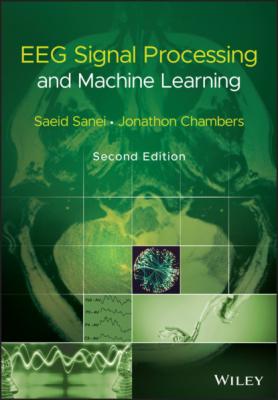EEG Signal Processing and Machine Learning. Saeid Sanei
Читать онлайн.| Название | EEG Signal Processing and Machine Learning |
|---|---|
| Автор произведения | Saeid Sanei |
| Жанр | Программы |
| Серия | |
| Издательство | Программы |
| Год выпуска | 0 |
| isbn | 9781119386933 |
In the treatment of various topics covered within this research monograph it is assumed that the reader has a background in the fundamentals of digital signal processing and wishes to focus on processing of EEGs. It is hoped that the concepts covered in each chapter provide a foundation for future research and development in the field.
In conclusion, we do wish to stress that in this book there is no attempt to challenge previous clinical or diagnostic knowledge. Instead, the tools and algorithms described in this book can, we believe, potentially enhance the significant clinically related information within EEG signals and thereby aid physicians and ultimately provide more cost effective and efficient diagnostic tools.
Both authors wish to thank most sincerely our previous and current PhD students who have contributed so much to the material in this work and our understanding of the field. Special thanks to Min Jing, Tracey Lee, Kianoush Nazarpour, Leor Shoker, Loukianous Spyrou, and Wenwu Wang, who contributed to providing some of the illustrations. Finally, this book became truly possible due to spiritual support and encouragement of Maryam Zahabsaniei, Erfan Sanei, and Ideen Sanei.
Saeid Sanei
Jonathon A. Chambers
January 2007
List of Abbreviations
3DThree‐dimensionalAASMAmerican Academic of Sleep MedicineACCAnterior cingulate cortexACEAddenbrooke’s cognitive examinationACRAccuracy of responsesACTAdaptive chirplet transformADAlzheimer’s diseaseADCAnalogue‐to‐digital converterADDAD patients with mild dementiaADDAttention‐deficit disorderADHDAttention‐deficit hyperactivity disorderAEApproximate entropyAEAutoencoderAEPAudio evoked potentialsAfCAffective computingAg–AgClSilver–silver chlorideAIArtificial intelligenceAICAkaike information criterionALEAdaptive line enhancerALFAdaptive standardized LORETA/FOCUSSALMAugmented Lagrange multipliers methodALSAlternating least squaresALSAmyotrophic lateral sclerosisAMDFAverage magnitude difference functionAMIAverage mutual informationAMMAugmented mixing matrixANNArtificial neural networkAODAuditory oddballAPAction potentialApEnApproximate entropyAPGARCHAsymmetric power GARCHARAutoregressive modellingARMAAutoregressive moving averageASCOTAdaptive slope of wavelet coefficient counts over various thresholdsASDAutism spectrum disorderASDAAmerican Sleep Disorders AssociationAsIAsymmetry indexASRAutomatic speaker recognitionASSAverage artefact subtractionAUCArea under the curveBASBehavioural activation systemBBCIBerlin BCIBBIBrain‐to‐brain interfaceBCGBallistocardiogramBCIBrain–computer interfacingBDSBrock, Dechert, and ScheinkmanBEMBoundary‐element methodBFBeamformerBGDBootstrapped geometric differenceBICBayesian information criterionBISBehavioural inhibition systemBISBispectral indexBMIBrain–machine interfacingBOLDBlood oxygenation level dependentBPBereitschaftspotentialBPBipolar disorderBrain/MINDSBrain Mapping by Integrated Neurotechnologies for Disease StudiesBSEBlind source extractionBSRBurst‐suppression ratioBSSBlind source separationbvFTDBehaviour variant frontotemporal dementiaCaCalciumCAEContractive autoencoderCANDECOMPCanonical decompositionCBDCorticobasal degenerationCBFCerebral blood flowCCACanonical correlation analysisCEEMDANComplete ensemble EMD with adaptive noiseCFCharacteristic functionCFCognitive fluctuationCFSChronic fatigue syndromeClChlorideCDLSACoupled dictionary learning with sparse approximationCDRCurrent distributed‐source reconstructionCICovariance intersectioncICAConstrained ICACITConcealed information testCJDCreutzfeldt–Jakob diseaseCMACircumplex model of affectsCMTFCoupled matrix and tensor factorizationsCMOSComplementary metal oxide semiconductorCNNConvolutional neural networkCNSCentral nervous systemCORCONDIACore consistency diagnosticCoSAMPCompressive sampling matching pursuitCPSCyber‐physical systemsCRBPFConstrained Rao‐Blackwellised particle filterCSACentral sleep apnoeaCSDCurrent source densityCSFCerebrospinal fluidCSPCommon spatial patternsCTComputerized tomographyDAEDenoising autoencoderDARPADefence Advanced Research Projects AgencyDASMDifferential asymmetryDBSDeep brain stimulationDCDirect currentDCAUDifferential CausalityDCMDynamic causal modellingDCTDiscrete cosine transformdDTFDirect directed transfer functionDEDifferential entropyDeconvNetDeconvolutional ANNDFTDiscrete Fourier transformDFVDominant frequency variabilityDHTDiscrete Hermite transformDLDiagonal loadingDLEDigitally linked earsDMDefault modeDMNDefault mode networkDNNDeep neural networkDPFDifferential pathlength factorDSMDiagnostic and Statistical ManualDSTCLNDeep spatio‐temporal convolutional bidirectional long short‐term memory networkDTDecision treeDTFDirected transfer functionDTIDiffusion tensor imagingDUETDegenerate unmixing estimation techniqueDWTDiscrete wavelet transformECDElectric current dipoleECDEquivalent current dipoleECGElectrocardiogramECGElectrocardiographyECoGElectrocorticogramECTElectroconvulsive therapyEDError distanceEEGElectroencephalogramEEGElectroencephalographyEEMDEnsemble empirical mode decompositionEGARCHExponential GARCHEGGElectrogastrographyEKGElectrocardiogramEKGElectrocardiographyEMExpectation maximizationEMDEmpirical mode decompositionEMGElectromyogramEMGElectromyographyENetEfficient neural networkEOGElectro‐oculogramEPEvoked potentialEPNEarly posterior negativityEPSPExcitatory post‐synaptic potentialERBMEntropy rate bound minimizationERDEvent‐related desynchronizationERNError‐related negativityERPEvent‐related potentialERSEvent‐related synchronizationFAFactor analysisFCFunctional connectivityFCMFuzzy c‐meansFDFractal dimensionFDAFood and Drug AdministrationFDispEnFluctuation‐based dispersion entropyFDRFalse detection rateFEMFinite element modelFFNNFeed forward neural networkFETField‐effect transistorfICAFast independent component analysisFIRFinite impulse responsefMRIFunctional magnetic resonance imagingFMSFibromyalgia syndromeFNFalse negativefNIRSFunctional near‐infrared spectroscopyFOForamen ovaleFOBSSFirst order blind source separationFOCUSSFocal underdetermined system solverFOOBIFourth order cumulant based blind identificationFPFalse positiveFRDAFrontal rhythmic delta activityFRNFeedback related negativityFSORFeature selection with orthogonal regressionFSPFalsely detected source number (position)FTDFrontotemporal dementiaFuzEnFuzzy entropyGAGenetic algorithmGADGeneral anxiety disorderGANGenerative adversarial networkGARCHGeneralized autoregressive conditional heteroskedasticityGARCH‐MGARCH‐in‐meanGCGranger causalityGCNGraph convolutional networkGFNNGlobal false nearest neighboursGJR‐GARCHGlosten, Jagannathan, & Runkle GARCHGLMGeneral linear modelGMMGaussian mixture modelGPGaussian processGP‐LRGaussian process logistic regressionGSCCAGroup sparse canonical correlation analysisGSRGalvanic skin responseGWNGaussian white noiseHBO/HbOOxyhaemoglobinHBR/HbRDe‐oxyhaemoglobinHBTTotal haemoglobinHCIHuman computer interactionHDHuntington’s diseaseHEOGHorizontal electro‐oculographHFDHiguchi's fractal dimensionHHTHilbert–Huang transformHMDHead‐mounted displayHMMHidden Markov modelHOPLSHigher‐order partial least squaresHOSHigher‐order statisticsHRHemodynamic responseHRFHaemodynamic response functionHTHilbert transformIAPSInternational affective picture systemIBEInternational Bureau for EpilepsyICIndependent componentICAIndependent component analysisiCOHImaginary part of coherencyIEDInterictal epileptiform dischargeiEEGIntracranial electroencephalogramICAIndependent component analysisIIRInfinite impulse responseILAEInternational League Against EpilepsyIMFIntrinsic mode functionImSCohImaginary part of S‐coherencyINDSCALINDividual Differences SCALingIoBInternet‐of‐brainsIPLInferior parietal lobuleIPSPInhibitory post‐synaptic potentialIRImpulse responseIRLSIterative recursive least squaresISODATAIterative self‐organizing data analysis technique algorithmIsomapIsometric mappingISSWTInverse synchro‐squeezing wavelet transformITRInformation transfer rateIVEImmersive virtual environmentsJADJoint approximate diagonalizationJADEJoint approximate diagonalization of eigenmatricesjICAJoint ICAKPotassiumKcKolmogorov complexityKDTKarolinska drowsiness testKLKullback–LeiblerKLTKarhunen–Loéve transformKMIKinaesthetic motor imageryKNNk‐nearest neighbourKPCAKernel principal component analysisKSSKarolinska sleepiness scaleKTKuhn–TuckerLBDLewy
